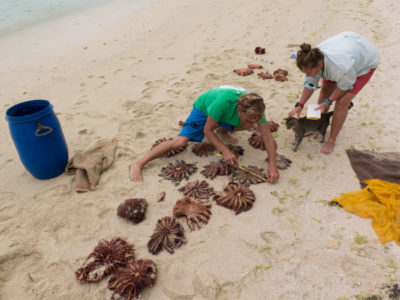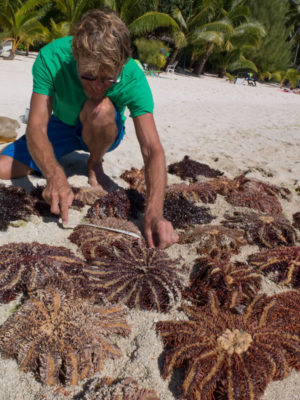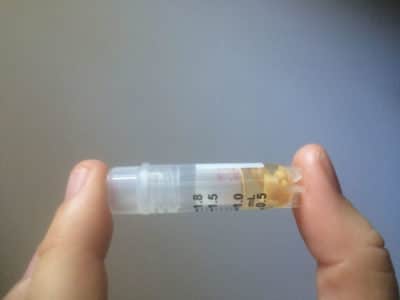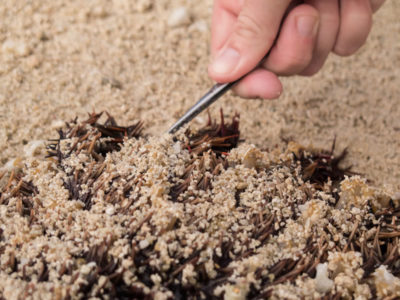Expedition Log: Cook Islands – Day 9
Coral reefs are considered one of the most productive and species-rich ecosystems in the world, but that doesn’t make them invulnerable to natural threats. The reefs in the Cook Islands have recently been plagued by the voracious coral predator, the crown of thorns starfish. Like locusts and other pests, they must be controlled when their population booms out of control. Crown-of-thorns starfish (COTS) have been estimated to consume about 5-6 square meters of coral tissue per year. That is almost 65 square feet of coral tissue eaten by one starfish! The starfish can move around on the reef quickly (as fast as 20 meters per hour over sand) seeking out patches of new coral to eat. The insatiable appetite of COTS is a cause for concern. Many scientists and resource managers support the immediate removal of these starfish from the reef during an outbreak to protect the long-term health of the coral reef ecosystem.

Andy Bruckner and Alex Dempsey measure and record the length of COTS collected off the Amuri lagoon reef in Aitutaki. (They were joined by a curious cat that came to check out our progress.)
The Living Oceans Foundation (LOF) has been researching COTS for the past 4 years. The reefs of Aitutaki in the Cook Islands experienced their first outbreak in 2009, and by 2013 when we first surveyed these reefs it had spread around the island, devastating fore reef communities. At the request of dive operators and the Aitutaki Island Council, our science team returned to Aitutaki to assess the extent of the damage and determine if our past removal efforts have helped save the remaining corals. On our first mission, we counted and measured the starfish and recorded where on the reef they were found. Now we’re back and doing that again, but this time we’re taking some of their feet with us.

Sampling COTS: Tubefeet being collected by Alex Dempsey. The spines on the underbelly of the starfish aren’t as sharp as the ones on their bodies, but you still have to be super careful not to get stung.
After COTS are collected, we place them onto the ground and measure the longest diameter across the starfish, typically from the tip of an arm on one end to the tip of the opposing arm on the other end. These measurements can help scientists bin the starfish into different size classes. While it is not possible to determine their exact age based on their size (because they can vary considerably depending on what corals they eat and how much they eat) it helps us determine if the outbreak originated from a single reproductive event or multiple events.

Andy Bruckner measuring COTS sizes to add to the LOF crown of thorns database.
COTS have been regarded as a single species throughout its wide geographic range, sharing the same physiological, ecological, behavioral traits wherever they are found. However, a small study conducted in 2013 suggests there might be more than one species of COTS. Since the publication of this study, the LOF science team has been sampling COTS by collecting their tube feet (small mobile tubular suckers that help the starfish move) from locations all over the Indo-Pacific, in an effort to verify the genetic diversity of these fascinating invertebrates. To collect the tube feet, we use forceps to carefully pull 8-10 tube feet from the underside of the starfish and place them in small vials with a chemical liquid to preserve its DNA.

Tubefeet being preserved in ethanol to keep the integrity and DNA of the sample.
The life history and behaviors of COTS is still relatively unknown, but research into speciation of these starfish could prove to be crucial for the design of applicable management strategies to help minimize catastrophic COTS outbreaks in the future.

Tubefeet being collected by Alex Dempsey, who is sure to leave out as much sand as possible in the sample.
Photos: 1-3 Carly Reeves, 4 Alex Dempsey
